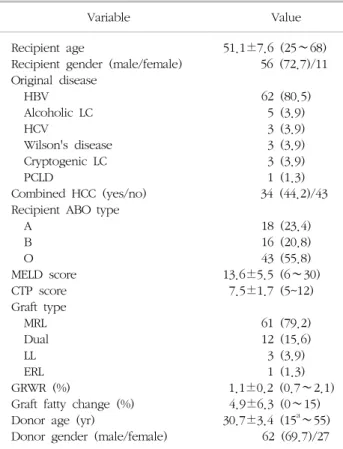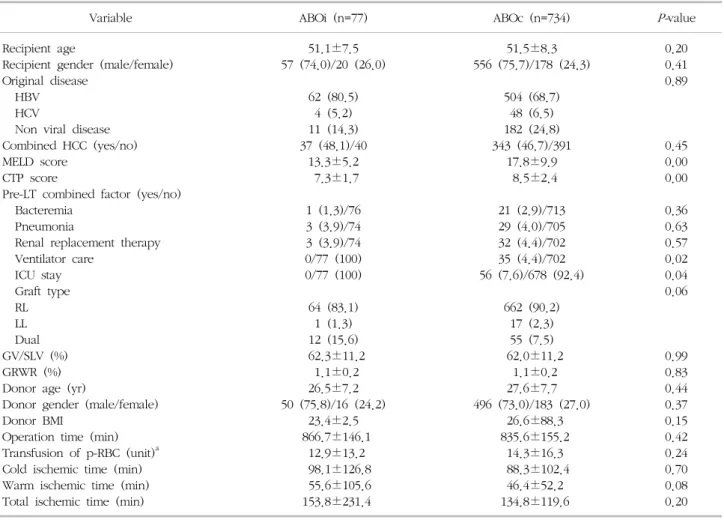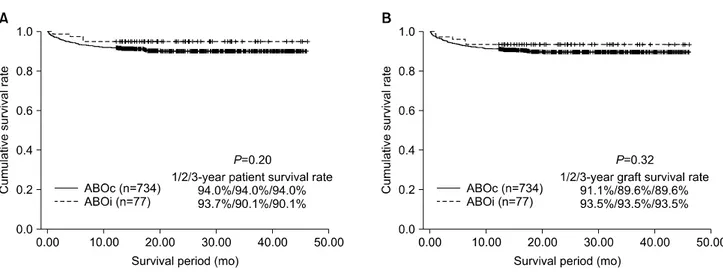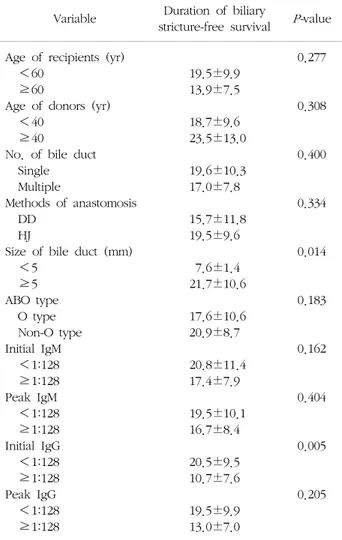책임저자:송기원, 서울특별시 송파구 올림픽로43길 88 울산대학교 의과대학 서울아산병원 외과, 138-736 Tel: 02-3010-5796, Fax: 02-474-9027 E-mail: drsong71@hotmail.com
접수일 : 2012년 10월 6일, 심사일 : 2012년 11월 8일 게재승인일 : 2012년 12월 12일
ABO 혈액형 부적합 성인 생체간이식 후 발생한 담도계 협착의 분석
울산대학교 의과대학 서울아산병원 외과
윤영인ㆍ송기원ㆍ이승규ㆍ황 신ㆍ안철수ㆍ김기훈ㆍ문덕복ㆍ하태용 정동환ㆍ박길춘ㆍ남궁정만ㆍ박요한ㆍ박천수ㆍ박형우ㆍ강성화ㆍ정보현
Analysis of Biliary Stricture after ABO Incompatible Adult Living Donor Liver Transplantation
Young-In Yoon, M.D., Gi-Won Song, M.D., Sung-Gyu Lee, M.D., Shin Hwang, M.D., Chul-Soo Ahn, M.D., Ki-Hun Kim, M.D., Deok-Bog Moon, M.D., Tae-Yong Ha, M.D., Dong-Hwan Jung, M.D., Gil-Chun Park, M.D., Jung-Man Namgung, M.D., Yo-Han Park, M.D., Chun-Soo Park, M.D., Hyoung-Woo Park, M.D., Sung-Hwa Kang, M.D. and Bo-Hyun Jung, M.D.
Department of Surgery, Asan Medical Center, University of Ulsan College of Medicine, Seoul, Korea
Background: Despite recent improvements in survival outcome after ABO incompatible (ABOi) adult living donor liver transplantation (ALDLT), concerns about the incidence of biliary stricture (BS) still exist. However, reports on the actual incidence of BS have been scarce.
Methods: From November 2008 to August 2011, 77 cases of ABOi ALDLTs have been performed. We compared patient and graft survival and BS-free survival rates (BSFSR) between these ABOi ALDLTs and 734 ABO compatible (ABOc) ALDLTs performed during the same period. We also analyzed characteristics of BS in ABOi ALDLT.
Results: There was one mortality (1.3%) and one re-transplantation (due to small-for-size graft syndrome) among 77 cases of ABOi ALDLTs. Overall, 1-, 2-, and 3-year patient survival rates were 94.8%, comparable to ABOc ALDLTs (93.7%, 90.1%, 90.1%, P =0.20). BS occurred in 11 (13.8%) ABOi ALDLT patients. There were no significant differences in 1-, 2-, and 3-year BSFSR between ABOi and ABOc ALDLT patients (87.5% vs. 88.1%, 83.4% vs. 87.5%, and 83.4% vs. 86.4%, P =0.55). Among 10 patients with BS, four patients showed diffuse multiple intrahepatic strictures, which were linked to the death of two patients.
Conclusions: The survival outcome of ABOi ALDLT is comparable to ABOc ALDLT. The incidence of BS of ABOi ALDLT was not superior to that of ABOc ALDLT. However, ABO incompatibility is related to the development of diffuse multiple intrahepatic BSs (rarely seen in ABOc ALDLT) and can cause graft failure and patient death.
Key Words: Blood group incompatibility, Bile duct stricture, Living donor liver transplantation 중심 단어: ABO 혈액형 부적합, 담도협착, 생체간이식
서 론
뇌사 기증자의 절대적인 부족으로 인해 생체간이식이 전체 간이식의 80% 이상을 차지하고 있는 국내 현실을 감안할 때 말기 간질환 환자들에게 보다 많은 치료 기회 를 제공하기 위해서는 뇌사자 장기기증을 활성화하기 위
한 방안뿐만 아니라 생체 기증자군의 확대를 위한 노력 이 필요하다. 그러나 기증자 안전을 저해하지 않아야 한 다는 전제 조건으로 인해 성인 생체간이식에서 생체 기 증자군의 확대에는 제한이 따를 수밖에 없으며 이런 측 면에서 ABO 혈액형 부적합 성인 생체간이식(ABOi adult living donor liver transplantation, ALDLT)은 기증자의 안전을 저해하지 않고 잠재적 기증자군을 확대할 수 있 는 효과적인 방안이다. 그러나 최근 ABOi ALDLT의 성적 이 현저히 향상되어 생체 기증자군 확대의 유용한 방법 으로 기대를 받고 있음에도 불구하고 여전히 ABO 혈액 형 부적합과 관련한 합병증들에 대한 지속적인 우려가 있어 ABOi ALDLT의 적용 확대에 저해요인으로 작용하
고 있다. 특히 성인 생체간이식의 가장 흔한 합병증 중의 하나인 담도협착의 발생 빈도가 ABOi ALDLT에서 훨씬 더 높을 것이라는 예측은 가장 중요한 장애 요소가 되고 있다(1). 그러나 ABOi ALDLT에서의 담도협착의 발생에 대한 문헌상의 보고는 매우 드물며 정확한 발생 빈도 및 임상 양상에 대해 알려진 바가 적다. 따라서, 저자들은 본원에서의 ABOi ALDLT의 임상 경험을 토대로 실제 ABOi ALDLT에서의 담도협착의 발생 빈도와 임상적인 특징을 분석해 보고자 하였다.
대상 및 방법 1) 연구 대상
본 연구는 의무기록 및 영상 자료를 토대로 한 후향적 연구로서 2008년 11월부터 2011년 8월까지 본원에서 ABOi ALDLT를 시행 받은 77명의 환자들을 연구 대상으 로 선정하여 이들의 생존율 및 이식편 생존율을 동 기간 동안 ABO 혈액형 적합 성인 생체간이식(ABOc ALDLT) 을 시행받은 734명의 생존율 및 이식편 생존율과 비교했 다. 또한 ABOi ALDLT와 ABOc ALDLT의 담도협착의 빈 도 및 무 담도협착 생존율을 비교하였다. 그리고 77명의 ABOi ALDLT를 시행받은 환자에서 담도협착이 발생한 군과 발생하지 않은 정상군 간의 임상적 지표의 차이를 비교 분석했다.
2) ABOi ALDLT에서의 이식 전 및 수술 중 처치
혈청 응집소의 역가를 줄이고 B림프구의 활성도를 억제 하기 위해 수술 전 rituximab 용량은 300∼375 mg/body surface area (mm2)를 2주 전 1회 정주하고 혈장교환술 을 시행했다. 혈장교환술의 시기 및 횟수는 혈청 응집소 역가에 따라 조정했으며 이식 직전 혈청 응집소 역가를 1:8 이하로 감소시키는 것을 목표로 했다. 혈청 응집소 역 가는 immunoglobulin M (IgM)과 immunoglobulin G (IgG) 중 높은 역가를 적용하였다.
간이식 수술은 통상적인 생체간이식 수술 술기를 이용 했으며, 담관문합은 두 명의 외과 전문의에 의해 시행되 었다. 전례에서 비장적출술은 시행하지 않았다. 2010년 11월부터 2011년 4월까지 ABOi ALDLT를 시행받은 초기 20예에서는 간동맥 혹은 간문맥을 통한 국소주입요법을 시행했으나 이후 증례에서는 국소주입요법을 사용하지 않았다.
3) 이식 후 면역억제요법 및 면역학적 감시
이식 후 주 면역억제요법은 tacrolimus, mycopheno-
late mofetil (MMF), methylprednisolone으로 구성되었 다. 이식 후 1개월까지 tacrolimus 혈중 농도는 8∼12 ng/mL로 유지했고 1개월 이후부터는 단계적으로 유지 농도를 낮추었다. MMF는 1.0 g/day를 사용했으며 전혈 구 수치 및 환자의 체중, 전신 상태 및 부작용 여부에 따 라 용량을 조정했다. 스테로이드 제제는 전례에서 무간 기에 methylprednisolone 10 mg/kg을 정주하였고 국소 주입요법을 사용한 군에서는 수술 후 국소 주입관을 통 하여 1주간 125 mg/day를 지속 주입한 후 3주째까지는 50 mg/day로 감량하여 주입했으며 3주 이후부터는 경구 용 제제로 전환 후 이식 후 3개월째까지 투여 후 중단했 다. 국소주입요법을 사용하지 않은 군에서는 통상적인 생체간이식에서 사용하는 용법에 따라 수술 직후 점진적 감량 후 3개월째까지 사용 후 중단했다. B림프구의 활성 도 및 항체 매개성 거부반응의 발생을 감시하기 위해 혈 청 응집소를 측정했다.
추적 관찰 중 혈청 아스파르테이트아미노전이효소, 알 라닌아미노전달효소 혹은 총 빌리루빈 치의 급격한 상승 과 함께 혈청 응집소가 1:128 이상으로 상승하는 경우 임 상적으로 항체 매개성 거부반응을 의심하여 우선 혈장교 환술을 시행하면서 간 조직 생검을 시행했고 생검상 항 체 매개성 거부반응으로 진단된 경우, 항체 매개성 거부반응 으로 확진하고 고용량 정맥주사용 면역글로블린(intravenous immunoglobulin, IVIG) (1.0 g/kg/day) 정주 및 스테로이 드 충격요법을 시행했다.
4) 담도협착의 진단 및 치료
혈액검사상 혈청 아스파르테이트아미노전이효소, 알라 닌아미노전달효소, 총 빌리루빈 혹은 알카라인포스파타 제의 농도가 기준치의 2배 이상 증가되면서 영상검사상 간내 담도의 확장 소견이 있는 경우 담도협착을 의심했 고 내시경적 역행성 담췌관 조영술(endoscopic retro- grade cholangiopancreatography, ERC) 혹은 경피적 경간 담관 조영술(percutaneous transhepatic cholangiography, PTC)로 확진했다. ABO 혈액형 부적합과 ABO 혈액형 적합 각각 두 개의 이식편을 이용한 생체간이식에서 한 개의 이 식편에서라도 담관협착이 발생하면, ABO 혈액형 부적합 담관협착으로 판단하였다. 또한 내시경적 역행성 담도배액 관(endoscopic retrograde biliary drainage)을 삽입하거나 경피적 경간 담도배액관(percutaneous transhepatic biliary drainage)을 유치하여 협착을 치료했다.
5) 통계적 분석
생존율은 Kaplan-Meier법으로 구하고 생존율의 비교에는
Table 1. Demographic and clinical data of 77 ABOi adult living donor liver transplantations
Variable Value
Recipient age
Recipient gender (male/female) Original disease
HBV Alcoholic LC HCV
Wilson's disease Cryptogenic LC PCLD
Combined HCC (yes/no) Recipient ABO type A
B O MELD score CTP score Graft type MRL Dual LL ERL GRWR (%)
Graft fatty change (%) Donor age (yr)
Donor gender (male/female)
51.1±7.6 (25∼68) 56 (72.7)/11
62 (80.5) 5 (3.9) 3 (3.9) 3 (3.9) 3 (3.9) 1 (1.3) 34 (44.2)/43
18 (23.4) 16 (20.8) 43 (55.8) 13.6±5.5 (6∼30)
7.5±1.7 (5~12) 61 (79.2) 12 (15.6) 3 (3.9) 1 (1.3) 1.1±0.2 (0.7∼2.1) 4.9±6.3 (0∼15) 30.7±3.4 (15
a∼55)
62 (69.7)/27 Data are presented as mean±SD (range) or number (%).
Abbreviations: HBV, hepatitis B virus; LC, liver cirrhosis; CTP, Child-Turcotte-Pugh; HCV, hepatitis C virus; PCLD, polycystic liver disease; HCC, hepatocelluar carcinoma; MELD, model for end-stage liver disease; MRL, modified right lobe; LL, left lobe; ERL, ex- tended right lobe; GRWR, graft-to-recipient weight ratio.
a
Deceased donor.
Table 2. Indication for liver transplantation in 77 ABOi adult liv- ing donor liver transplantations
Indication for liver transplantation No. of cases (%) Unresectable HCC
Recurrent HEP
Intractable ascites/hydrothorax Recurrent SBP
Varix bleeding Others
30 (38.96) 11 (14.28) 13 (16.88) 3 (3.89) 15 (19.48)
5 (6.49) Abbreviations: HCC, hepatocelluar carcinoma; HEP, hepatic ence- phalopathy; SBP, spontaneous bacterial peritonitis.
Table 3. The ABO blood group combinations in 77 ABOi adult living donor liver transplantations
Recipient and donor relation
R←D No. of cases (%)
Recipient blood type O (n=43) O←A
O←B O←AB
Recipient blood type A (n=18) A←B
A←AB
Recipient blood type B (n=16) B←A
B←AB Total
25 (32.5) 17 (22.1) 1 (1.3) 10 (13.0) 8 (10.4) 8 (10.4) 8 (10.4) 77 (100.0)
log-rank test를 이용했다. 담도협착군과 정상군 간의 임상지표의 비교에 있어서는 범주형 자료에 대해서 chi-square test 혹은 Fisher's exact test를 이용했고 비범주형 자료에 대해서는 Student's t-test 혹은 Mann-Whitney test를 이용 했다. P값 0.05 미만을 통계적으로 유의한 것으로 간주 했다.
결 과
1) ABOi ALDLT 환자의 임상 정보
2008년 11월부터 2011년 8월까지 본원에서 ABOi ALDLT를 시행받은 환자는 77명으로 동일 기간 동안 시 행된 전체 성인 생체간이식의 9.5% (77/811)를 차지했 다. 이들 중 남성이 56명(72.7%), 여성이 11명이었으며 평균 연령은 51.1±7.6 (범위, 25∼68)세였다. 원인 질환
으로는 B형 간염에 의한 간경변이 62명(80.5%)으로 가장 많았고 34명(44.2%)에서 원발성 간세포암을 동반하고 있 었다. 77명의 인구학적 자료를 포함한 임상 자료는 Table 1에 요약했으며 간이식을 시행하게 된 직접적인 원인은 Table 2에 요약했다. 수혜자의 ABO 혈액형은 O 형이 43명(55.8%)으로 가장 많았고 ABO혈액형 부적합 조합은 O형 수혜자-A형 기증자 조합이 25건(32.5%)으로 가장 많았다(Table 3).
수술 전 평균 model for end-stage liver disease (MELD) score는 13.6±5.4 (범위, 6∼30), Child-Turcotte-Pugh (CTP) score는 7.5±1.7 (범위, 5∼12)이었다. 이식편의 형태는 변형 우엽이 61예(79.2%), 두 개의 이식편(dual graft)이 12예(15.6%), 좌엽이 3예(3.9%), 확대 우엽이 1 예(1.3%) 사용되었다. 12예의 두 개의 이식편을 이용한 생체간이식에서 9명에서는 이식편이 각각 ABO 혈액형 부적합과 ABO 혈액형 적합이었으며 3명에서는 두 개 모 두 ABO 혈액형 부적합 이식편이었다.
총 89명의 기증자들 중 88명이 생체 기증자였고 1명의
Table 4. Comparison of demographic and clinical data between ABOi and ABOc living donor liver transplantations
Variable ABOi (n=77) ABOc (n=734)
P-value
Recipient age
Recipient gender (male/female) Original disease
HBV HCV
Non viral disease Combined HCC (yes/no) MELD score
CTP score
Pre-LT combined factor (yes/no) Bacteremia
Pneumonia
Renal replacement therapy Ventilator care
ICU stay Graft type RL LL Dual GV/SLV (%) GRWR (%) Donor age (yr)
Donor gender (male/female) Donor BMI
Operation time (min) Transfusion of p-RBC (unit)
aCold ischemic time (min) Warm ischemic time (min) Total ischemic time (min)
51.1±7.5 57 (74.0)/20 (26.0)
62 (80.5) 4 (5.2) 11 (14.3) 37 (48.1)/40
13.3±5.2 7.3±1.7 1 (1.3)/76 3 (3.9)/74 3 (3.9)/74 0/77 (100) 0/77 (100) 64 (83.1)
1 (1.3) 12 (15.6) 62.3±11.2
1.1±0.2 26.5±7.2 50 (75.8)/16 (24.2)
23.4±2.5 866.7±146.1
12.9±13.2 98.1±126.8 55.6±105.6 153.8±231.4
51.5±8.3 556 (75.7)/178 (24.3)
504 (68.7) 48 (6.5) 182 (24.8) 343 (46.7)/391
17.8±9.9 8.5±2.4 21 (2.9)/713 29 (4.0)/705 32 (4.4)/702 35 (4.4)/702 56 (7.6)/678 (92.4)
662 (90.2) 17 (2.3) 55 (7.5) 62.0±11.2
1.1±0.2 27.6±7.7 496 (73.0)/183 (27.0)
26.6±88.3 835.6±155.2
14.3±16.3 88.3±102.4
46.4±52.2 134.8±119.6
0.20 0.41 0.89
0.45 0.00 0.00 0.36 0.63 0.57 0.02 0.04 0.06
0.99 0.83 0.44 0.37 0.15 0.42 0.24 0.70 0.08 0.20 Data are presented as mean±SD (range) or number (%).
Abbreviations: HBV, hepatitis B virus; HCV, hepatitis C virus; HCC, hepatocelluar carcinoma; MELD, model for end-stage liver disease;
CTP, Child-Turcotte-Pugh; LT, liver transplantation; ICU, intensive care unit; RL, right lobe; LL, left lobe; GV/SLV, graft volume/standard liver volume; GRWR, graft-to-recipient weight ratio; BMI, body mass index; RBC, red blood cell.
a
During operation.
뇌사 기증자에서 두 개의 이식편을 이용한 생체간이식을 위해 좌외분절을 구득했다. 기증자들 중 남성이 62명 (69.7%), 여성이 27명이었으며, 평균 연령은 30.7±3.4 (범위, 15∼55)세였다. 기증자 사망 예는 없었으며 수술 후 합병증으로는 간 절제연에서의 담즙 유출이 3명에서 발생했으며 모두 보존적 치료로 회복되었다.
2) ABOi ALDLT 및 ABOc ALDLT의 임상 지표 및 생존율 비교
77명의 ABOi ALDLT 환자들과 734명의 ABOc ALDLT 환자들의 임상 지표를 비교했을 때 MELD score가 각각 13.6±5.4와 17.9±10.0으로 ABOi ALDLT군에서 유의하 게 낮았으며(P=0.00) CTP score 또한 ABOi ALDLT군에 서 유의하게 낮았다(7.3±1.7 vs. 8.5±2.5, P=0.00). 또
한 ABOc ALDLT군에서 수술 전 중환자실 재원율(7.5%
vs. 1.3%, P=0.04)과 인공호흡기 사용률(4.8% vs. 0%, P=0.03)이 유의하게 높았다. 그러나 수혜자 및 기증자의 이외의 임상 지표들에서는 유의한 차이를 보이지 않았다 (Table 4). 이식 후 titer의 증가로 plasmapheresis를 시 행한 환자는 총 29명이었으며, 급성 거부반응(acute anti- body-mediated rejection)은 ABOi ALDLT군에서 발생하 였고, 해당 환자에서 다발성 협착이 발생하였다. 특히, 감염성 합병증이 발생한 환자는 총 13명으로 결핵 1명, 진균 감염 2명, 균혈증 3명, 폐렴 5명, 급성 요로감염 1 명, 뇌염 1명 등이 있었다.
ABOi ALDLT 환자 중 원내 사망은 수술 후 21일째 발 생한 폐렴에 의한 1예가 있어 원내 사망률은 1.3%로 원 내 사망 건수가 28예(3.8%) 발생한 ABOc ALDLT에 비해
Fig. 1. Comparison of 1-, 2-, and 3-year patient (A) and graft (B) survival rates between ABO incompatible (ABOi) and ABO compatible (ABOc) adult living donor liver transplantations.
Fig. 2. Comparison of 1-, 2-, and 3-year biliary stricture-free sur- vival rate between ABO incompatible (ABOi) and ABO compatible (ABOc) adult living donor liver transplantation. Abbreviation: BS, biliary stricture.
낮았으나 통계적 유의성은 없었다(P=0.11). 1년, 2년 및 3년 환자 생존율은 ABOi ALDLT에서 94.8%였으며 ABOc ALDLT에서는 각각 93.7%, 90.1%, 90.1%로 통계적으로 유의한 차이가 없었다(Fig. 1A). 추적 기간 중 ABOi ALDLT군에서는 작은 이식편 증후군(small-for-size graft syndrome)으로 인해 1명(1.3%)의 환자에서 재이식이 시 행되었으며 ABOc ALDLT군에서는 3명(0.4%)의 환자에 서 재이식이 시행되었고 두 군 사이의 이식편 생존율에 있어서도 통계적으로 유의한 차이는 없었다(Fig. 1B).
3) ABOi ALDLT 및 ABOc ALDLT군 사이의 담도협착 발 생률 비교
ABOi ALDLT군에서 10예(13.0%)의 담도협착이 발생하
였고 ABOc ALDLT군에서는 88예(12.0%)의 담도협착이 발생하여 두 군 사이에서 담도협착의 발생 빈도에는 유 의한 차이가 없었다(P=0.46). 1년, 2년 및 3년 무 담도협 착 생존율은 ABOi ALDLT군에서 각각 87.5%, 83.4%, 83.4%였으며 ABOc ALDLT군에서는 각각 88.1%, 87.5%, 86.4%로 통계적으로 유의한 차이가 없었다(Fig. 2). 다만 ABO 혈액형 부적합 생체간이식(ABOi living donor liver transplantation, LDLT)에서 발생한 10예의 담도협착 중 4예는 간내 담도의 미만성 협착 소견을 보였으며(Fig.
3), 이 중 2예에서는 담도염에 속발한 폐혈증에 의해 사 망을 초래했다. 4예의 간내 담도 미만성 협착의 임상적 특징들은 Tables 5, 6에 요약했다.
ABOi ALDLT군 내에서 기증자 및 수혜자의 나이, 담 관의 개수 혹은 크기, 접합술의 방법, 기증자의 혈액형, 수혜자의 IgM과 IgG 항체가에 따른 담도협착까지의 기 간을 비교한 결과에서 담관의 크기가 5 mm 미만일 때와 수혜자의 초기 IgG 항체가가 1:128 이상일 때 담도협착 이 유의하게 짧은 기간 내 발생하는 것을 확인하였다 (Table 7). 이변량 분석에서 유의한 인자를 대상으로 다 변량 분석을 실시한 결과 Table 8과 같이 통계적으로 유 의한 인자를 확인하였다.
고 찰
고형 장기이식의 초기 경험에서 간은 다른 고형 장기 와 달리 면역학적으로 특혜 받은 장기(immunologically privileged organ)로 여겨져 ABO 혈액형에 상관없이 이 식을 시행하고자 하는 시도가 있었다(2). 이런 시도의 이 론적 근거는 1) 간은 간문맥과 간 동맥으로 이중 혈류 공
Fig. 3. Diffuse multiple intrahepatic biliary strictures in (A) case 7, (B) case 25, (C) case 29, and (D) case 34.
Table 5. Clinical characteristics of diffuse multiple intrahepatic biliary strictures No. of
case Age/Gender Disease MELD/CTP Graft type GRWR BD anastomosis
No. of duct
opening CIT (min) WIT (min) TIT (min) 7
25 29 34
54 / M 58 / M 61 / M 53 / M
HBV HBV HCC HBV HCC HBV HCC
14 / 10 25 / 7 14 / 7 7 / 7
MRL MRL MRL MRL
0.89 1.24 0.80 1.04
Single DD Single DD Multiple DD Single DD
1 1 2 1
55 62 101 103
49 53 37 44
104 115 138 147 Abbreviations: M, male; MELD, model for end-stage liver disease; CTP, Child-Turcotte-Pugh; GRWR, graft-to-recipient weight ratio; BD, bile duct; CIT, cold ischemic time; WIT, warm ischemic time; TIT, total ischemic time; HBV, hepatitis B virus; MRL, modified right lobe; DD, duct-to-duct anastomosis; HCC, hepatocelluar carcinoma.
Table 6. Clinical characteristics of diffuse multiple intrahepatic biliary strictures No. of
case
Initial CD 19(+) B cell(%)
Peak CD 19(+) B cell (%)
aInitial IgM/IgG
Peak IgM/IgG
aNo. of pre/post-LT PE
AHR
(+/-) Tx of BS Final
7 25 29 34
7.5 5.4 9.2 19.6
9.9 6.9 1.3 3.6
64/0 96/32 128/128
64/0
64/0 48/32 64/256 2,048/0
4/6 4/0 4/7 3/8
−
−
+
−
ERBD PTBD ERBD ERBD PTBD
Dead (4.1) Dead (6.3) Alive (23.0) Alive (22.3) Abbreviations: IgM, immunoglobulin M; IgG, immunoglobulin G; LT, liver transplantation; PE, plasma exchange; AHR, acute humoral rejection; Tx, treatment; BS, biliary stricture; ERBD, endoscopic retrograde biliary drainage; PTBD, percutaneous transhepatic biliary drainage.
a
After operation.
급을 받는다는 점, 2) 간은 용적이 크고 높은 재생 능력 을 가지고 있다는 점, 3) 간에 존재하는 간 대식구 (hepatic macrophage)와 같은 청소체계(scavenger sys-
tem)가 면역반응의 부산물을 신속하게 제거할 수 있다는 점이었다. 그러나 초기 경험에서 예상과는 달리 ABO 혈 액형 부적합 간이식의 성적은 매우 불량하여 1개월 내
Table 8. Multivariate analysis for the risk factors associated with duration of biliary stricture-free survival in 77 ABOi adult living donor liver transplantations
Variable Odds
ratio
95% confidence interval
P-value Size of bile duct (<5 mm)
Initial serum IgG (≥1:128) 5.415 3.383
1.523∼20.556 1.276∼16.436
0.023 0.035 Abbreviation: IgG, immunoglobulin G.
Table 7. Univariate analysis for risk factors associated with du- ration of biliary stricture-free survival in 77 ABOi adult living donor liver transplantations
Variable Duration of biliary
stricture-free survival
P-value Age of recipients (yr)
<60 ≥60
Age of donors (yr) <40
≥40
No. of bile duct Single Multiple
Methods of anastomosis DD
HJ
Size of bile duct (mm) <5
≥5 ABO type O type Non-O type Initial IgM <1:128 ≥1:128 Peak IgM <1:128 ≥1:128 Initial IgG <1:128 ≥1:128 Peak IgG <1:128 ≥1:128
19.5±9.9 13.9±7.5 18.7±9.6 23.5±13.0 19.6±10.3 17.0±7.8 15.7±11.8
19.5±9.6 7.6±1.4 21.7±10.6 17.6±10.6 20.9±8.7 20.8±11.4
17.4±7.9 19.5±10.1
16.7±8.4 20.5±9.5 10.7±7.6 19.5±9.9 13.0±7.0
0.277
0.308
0.400
0.334
0.014
0.183
0.162
0.404
0.005
0.205
Abbreviations: DD, duct-to-duct anastomosis; HJ, hepaticoje- junostomy; IgM, immunoglobulin M; IgG, immunoglobulin G.
이식편 소실률이 46%로 보고되었고 40∼50%에 이르는 높은 빈도의 거부반응 발생률과 30∼50%에 불과한 낮은 이식편 생존율이 보고되었다(3-5).
ABO 혈액형 부적합 간이식에서 발생하는 이식편 손상 의 병태생리는 Demetris 등(6)에 의해서 처음 기술되었 는데, 공여자의 ABO 항원과 수혜자의 항 ABO 항체 간 의 항원-항체 반응에 의해 보체계가 활성화되고 활성화 된 보체에 의한 직접적인 세포 손상 및 연쇄적인 염증반 응이 유발된다. 이는 파종성 혈관내 응고증에 의한 혈관 폐색과 허혈성 손상이 주 원인으로 밝혀졌으며 이 현상 을 항체 매개성 거부반응 혹은 체액성 거부반응이라고 한다. 반면 면역체계가 미성숙한 영유아에서는 ABO 혈 액형 부적합 간이식의 만족할만한 결과가 보고되었고, 따
라서 ABO 혈액형 부적합 간이식은 ABO 혈액형이 적합 한 기증자가 없고 즉각적으로 이식을 시행하지 않으면 기대여명이 수일에 불과한 긴박한 상황이거나 영유아 환 자의 경우에 한해서만 선택적으로 시행하도록 권고되었 다(7-9). 그러나 불량한 결과에도 불구하고 뇌사 기증자 의 수가 절대적으로 부족한 지역, 특히 일본을 중심으로 생체 기증자군의 확대가 절실히 필요한 상황에 의해 ABOi LDLT가 시행됐고 타당성에 대한 이견이 있었다.
그러나 ABO 혈액형 부적합 장기이식에서의 병태생리 에 대한 이해가 깊어짐에 따라 최근 이식편의 손상기전 을 회피하기 위한 여러 전략들이 개발되면서 영유아뿐만 아니라 성인에서도 ABOi LDLT의 성적이 현저하게 개선 되었고 약 70∼80%에 이르는 3년 생존율이 보고되고 있 다(10-12). ABO 혈액형 장벽(ABO blood group barrier) 을 극복하기 위한 여러 전략들 중 Tanabe 등(12,13)이 소개한 간문맥 주입요법은 ABOi LDLT의 성적 향상에 결 정적인 기여를 하게 되며 이후 간동맥을 통한 주입요법이 소개되었다(14). 무엇보다 항CD-20 단일항체(rituximab) ABO 혈액형 부적합 신장이식에서 이식 후 B림프구 증식 및 혈청 응집소 생성을 효과적으로 억제하여 성공적인 결과를 가져왔다는 보고가 있은 후 ABO 혈액형 부적합 고형 장기이식에서 rituximab 전 처치는 항체 매개성 거 부반응을 예방하기 위한 필수적인 치료과정으로 받아들 여지게 되었다(15,16). 또한 이미 체내에 존재하는 혈청 응집소의 제거를 위해서 수술 전 혈장교환술을 적극적으 로 활용해야 하며 수술 후에도 혈청 응집소의 농도에 따 라 혈장교환술을 적절히 시행하는 것이 치료의 원칙으로 자리잡게 되었다. 이들 외에도 비장적출술, 고용량 IVIG, immunoabsorbent column, cyclophosphamide 등이 이 용되기도 한다(17-19).
비록 최근 국내에서는 ABOi ALDLT를 시행하는 기관 이 조금씩 늘어나고 있으나 여전히 ABOi ALDLT의 안전 성에 대해서는 우려가 남아있다. 특히 초기 소규모의 연 구에서 보고된 성공적인 결과만을 가지고 확대 적용하기
에는 위험이 따르며 특히 장기적인 추적 관찰 시 발생될 수 있는 합병증, 특히 담도협착에 대해서는 여전히 높은 수술의 우려가 있다. 본원에서도 초기 소규모 증례에서 짧은 추적 관찰 기간 동안의 성공적인 결과를 얻어 보고 한 바 있었으나 장기 추적 관찰의 결과는 보고하지 못하 였다(20,21). 그러나, 본 연구를 통해 77예라는 비교적 많은 증례에서 비교적 긴 관찰 기간(평균 22.5개월) 동안 ABOi ALDLT의 성적이 ABOc ALDLT의 성적과 통계적으 로 유의한 차이를 보이지 않는다는 결론을 얻을 수 있었 다. Kawagishi 등(22)도 비록 11예를 대상으로 한 소규 모 연구이지만 평균 7.3년의 추적 관찰 기간을 통해 ABOi ALDLT의 양호한 결과를 보고한 바 있다. 이는 비 록 발생 시기 및 그 기전에 대해서는 정확히 알려진 바 가 없으나 이식 후 약 2∼4주 사이에 면역학적 관용이 발생하며 이로 인해 이식 후 약 1개월 이내에 ABO 부적 합에 의한 이식편 손상을 극복한다면 이후의 경과는 ABOc ALDLT와 유사한 경과를 취할 것이라는 예측을 뒷 받침한다고 할 수 있겠다(23,24).
다만 본 연구에서 ABOi ALDLT군의 생존율이 양호했 던 것은 결과에서 보였던 것처럼 ABOi ALDLT군에서 MELD, CTP score가 유의하게 낮고 이식 전 중환자실 재 원율 및 인공호흡기 사용률이 현저하게 낮았던 점으로 미루어 이식 전 환자의 전신 상태가 ABOc ALDLT군에 비해 현저히 양호했던 점에 기인한다고 볼 수 있다.
Egawa 등(11)의 연구에서 ABOi ALDLT의 생존율에 영향 을 미치는 가장 중요한 인자는 이식 전 MELD score였으 며 ABOi ALDLT 후 가장 흔한 사망 원인은 감염성 합병 증이었다. 이는 이식 전 전신 상태가 불량하고 매우 진행 된 간경변이 동반된 환자의 경우 감염의 발생에 취약하 다는 사실을 뒷받침하며 MELD score가 높거나 수술 전 전신 상태가 악화된 환자에서 ABOi ALDLT를 시행할 경 우 수술 전 rituximab의 사용과 수술 후 비교적 강한 면 역억제요법의 적용 시 높은 감염성 합병증의 발생과 불 량한 성적이 예상된다는 우려가 있을 수 있다. 따라서 본 연구에서처럼 비록 ABOi ALDLT의 생존율이 ABOc ALDLT의 생존율에 비해 낮지 않지만 환자의 선택에 있 어서 아직은 조심스러운 접근이 필요할 것이라 생각하며, 보다 개별화된 면역억제요법의 개발과 적용이 이런 한계 점을 극복하는 데 큰 도움이 될 것으로 판단된다.
성인 생체간이식에서 가장 흔한 합병증은 담도협착이 다. 보고에 따라서 발생 빈도의 차이가 있으나 평균적으 로 10∼30% 정도의 빈도로 보고되고 있으며 발생을 촉 진시키는 인자들로는 급만성 거부반응, cytomegalovirus 감염, 간동맥 협착 혹은 혈전증, ABO 혈액형 부적합, 사
람백혈구항원 교차반응 양성, 원발성 담도성 경화증 등과 같은 원인 질환의 재발 등이 거론되어 왔으나 생체간이 식에 있어서 무엇보다 중요한 인자는 이식편의 해부학적 특성인 이식편의 담도 개구부의 개수나 크기에 가장 큰 영향을 받는다고 볼 수 있다(25-27). 즉, 개구부의 개수 가 2개 이상의 다발성이거나 크기가 작을수록 담도협착 의 발생 위험도가 현저히 높아진다. 본 연구에서 역시 담 관의 크기가 5 mm 미만일 때 담도협착의 위험이 5 mm 이상인 환자군에 비해 5.4배 상승하는 것으로 확인되었 다. 그러나 이런 해부학적 조건이 동일한 상황에서 ABO 혈액형 부적합이 담도협착 발생의 부가적인 위험요소가 될 수 있다. 본 연구에서도 ABOi ALDLT 환자들에서 수 혜자의 초기 IgG 항체가가 1:128 이상일 때, 담도협착의 위험이 1:128 미만인 환자군에 비해 3.38배 상승하는 것 으로 확인되었다. 따라서, 면역반응과 관련이 있는 ABO 혈액형 부적합성이 담도 손상과 속발된 협착의 발생에 어느 정도 연관성이 있을 것으로 예상된다. 또한 ABOi ALDLT에서 담도협착의 발생 빈도를 줄이기 위해서는 이 식 후 통상적인 간기능검사 결과가 정상이라 하더라도 혈청 응집소의 변화를 유의 깊게 추적 관찰하여 추가적 인 혈장교환술이나 B림프구 억제요법을 사용하여 혈청 응집소의 증가를 예방할 필요가 있다고 할 수 있다.
Egawa 등(28)도 ABOi ALDLT에서 발생하는 담도협착을 항체 매개성 거부반응에 의한 이식편 손상과 동일 기전 에 의해 발생하는 것으로 이해해야 한다고 주장한 바 있 으며 본 연구에서도 단순한 문합부 유착이 아니라 간내 담도의 미만성 협착의 경우 ABO 혈액형 부적합에 의한 담도 손상이 담도협착의 주된 원인이라고 볼 수 있다. 비 록 증례 수가 적어 통계적으로 유의한 위험인자를 밝혀 내지는 못하였지만 4명의 환자 중 1명은 항체 매개성 거 부반응을 경험하였고 1명에서는 이식 후 혈청 응집소가 1:2,048까지 증가한 것으로 보아 이식 후 혈청 응집소의 증가가 담도협착의 주된 원인이 되는 것으로 추정된다.
또한, 4명 중 2명의 환자가 담도성 패혈증으로 사망했는 데 치료를 위해서는 패혈성 합병증의 발생 전 빠른 재이 식만이 유일한 치료법이다. 따라서 ABOi ALDLT 후 영상 검사상 미만성의 간내 담도의 다발성 협착 소견이 보이 면서 간기능의 이상 소견을 보일 경우, 보다 적극적으로 재이식에 대한 계획을 조기에 수립하고 감황 및 담도감 압 등 패혈성 합병증을 예방하기 위한 치료를 적시에 시 행해야 한다.
결 론
결론적으로 ABOi ALLDT의 생존율은 ABOc ALDLT의 생존율에 비해 불량하지 않으며 담도협착의 발생 빈도는 높지 않다. 다만 ABOc ALDLT에서 매우 드물게 발생하 는 미만성의 간내 담도협착의 발생이 ABOi LDLT에서는 관찰되며 ABO 혈액형 부적합성이 발생 원인으로 추정된 다. 따라서 ABOi ALDLT에서 전체적인 담도협착의 발생 을 줄이고 치명적인 미만성의 간내 담도협착의 발생을 예방하기 위해서는 이식 후 혈청 응집소 농도의 면밀한 추적 관찰과 추가적인 혈장교환술 및 B림프구 억제치료 를 적극적으로 활용해야 한다.
REFERENCES




